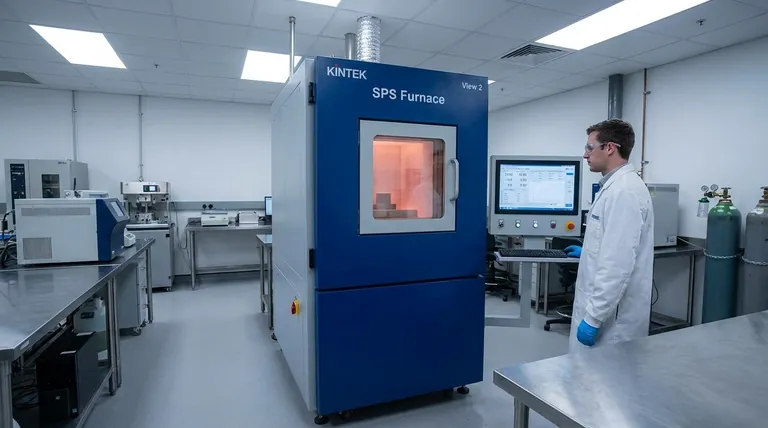スパークプラズマ焼結(SPS)で使用される圧力は、単一の固定値ではなく、重要かつ調整可能なプロセスパラメータです。ほとんどの材料と用途において、一軸圧力は通常、30~100メガパスカル(MPa)の範囲に収まります。この圧力は、急速な抵抗加熱と連携して、従来の焼結方法よりもはるかに効果的に緻密化を達成します。
中心的な課題は、単一の正しい圧力を見つけることではなく、その役割を理解することです。SPSにおける圧力は、熱エネルギーを補完する主要な機械的力であり、適切なレベルを選択することは、緻密化の促進、微細構造の維持、および装置の物理的限界の尊重の間で意図的なバランスを取ることです。
SPSにおける圧力の基本的な役割
圧力は受動的な変数ではなく、固化プロセスの積極的な推進力です。それは、パルスDC電流によって生成される高温と並行して機能し、緩い粉末を緻密な固体に変換します。
粒子固化の促進
サイクルのごく初期段階で、圧力は粒子の再配列を促進します。柔らかい凝集塊を分解し、個々の粒子をより密に充填された配置に強制的に押し込み、実質的な加熱が発生する前に初期の気孔率を大幅に低減します。
塑性変形の実現
温度が上昇すると、材料の降伏強度が低下します。加えられた圧力は、現在可塑性のある粒子を接触点で変形させます。この塑性流動は、粒子間の空隙を物理的に閉じるSPSの主要なメカニズムであり、急速な緻密化につながります。
物質移動の促進
加えられた圧力によって生成される応力勾配は、粒界拡散や体積拡散などの拡散プロセスの駆動力を増加させます。これは、原子が残りの微細な気孔を埋めるためにより容易に移動することを意味し、理論密度にほぼ達するために不可欠なプロセスです。

最適な圧力を決定する主要因
「正しい」圧力は、材料、目標、および装置に完全に依存します。標準値を盲目的に適用すると、最適ではない結果につながります。
材料の種類:脆性 vs. 延性
セラミックス(例:炭化ケイ素、炭化ホウ素)のような硬く脆い材料は、塑性流動に対する抵抗が大きいです。これらは、緻密化に必要な変形を誘発するために、しばしばより高い圧力(70~100 MPa以上)を必要とします。
逆に、アルミニウムや銅のような延性材料は容易に変形します。これらは、極端な温度を必要とせずに、しばしば低~中程度の圧力(30~60 MPa)で完全に緻密化することができます。
望ましい微細構造:密度 vs. 結晶粒径
SPSの主な利点の1つは、結晶粒成長を抑制しながら緻密な材料を製造できることです。より高い圧力を使用すると、多くの場合、より低い温度またはより短い時間で緻密化が可能になります。これは、微細粒またはナノ構造の微細構造を維持するための重要な戦略です。
装置の制限:グラファイトダイ
SPS実験の大部分は、グラファイトダイとパンチを使用して行われます。標準グレードのグラファイトは、高温での圧縮強度が限られており、通常、使用可能な圧力は約100~120 MPaに制限されます。この制限を超えると、ダイの壊滅的な破損のリスクがあり、装置を損傷し、サンプルを台無しにする可能性があります。
トレードオフの理解:圧力のジレンマ
圧力設定の選択には、競合する要因のバランスを取ることが含まれます。ある領域で役立つものが、別の領域では有害になる可能性があります。
過剰な圧力を使用するリスク
過剰な圧力を加えると、いくつかの問題が発生する可能性があります。最も直接的なのはダイの破損です。さらに、力の単軸性は、結晶粒が伸びたり、優先的に配向したりする異方性微細構造を作成し、方向によって異なる機械的特性につながる可能性があります。脆性粉末の場合、圧力を過度に強く加えると、サンプルに亀裂が生じる可能性もあります。
圧力が低すぎる場合の結果
不十分な圧力は、結果が悪い一般的な原因です。圧力が低すぎると、すべての気孔を閉じるために必要な塑性流動と粒子再配列を誘発するのに十分ではない可能性があります。これにより、最終密度が低いサンプルとなり、結果として機械的特性が低下します。これを補うために、より高い温度を使用せざるを得なくなり、望ましくない結晶粒成長のリスクが増大する可能性があります。
アプリケーションに適した圧力の選択
普遍的な公式はありませんが、主要な目的に基づいた明確なガイドラインがあります。類似材料に関する文献のベースラインから始め、特定の目標に基づいて最適化します。
- 硬質セラミックスで最大密度を達成することが主な焦点の場合: 材料固有の緻密化抵抗を克服するために、ダイの能力の上限(例:80~100 MPa)から始めます。
- ナノ構造を維持することが主な焦点の場合: 固化を達成する最低限の圧力(通常30~50 MPa)を使用し、非常に高い加熱速度と最小限の保持時間を組み合わせて、結晶粒粗大化を防ぎます。
- 延性金属の焼結が主な焦点の場合: 中程度の圧力(例:40~60 MPa)は、通常、塑性流動を誘発し、極端な温度を必要とせずに完全な密度を達成するのに十分です。
最終的に、圧力は、材料の最終状態を正確に設計するために、温度と並行して操作する不可欠なレバーです。
要約表:
| 材料の種類 | 一般的な圧力範囲 (MPa) | 主な目標 |
|---|---|---|
| 脆性セラミックス(例:SiC) | 70 - 100+ | 最大密度 |
| 延性金属(例:Al、Cu) | 30 - 60 | 完全緻密化 |
| ナノ構造材料 | 30 - 50 | 結晶粒成長抑制 |
SPSプロセスを最適化する準備はできましたか?
適切な圧力を選択することは、パズルのほんの一部にすぎません。KINTEKは実験装置と消耗品を専門とし、スパークプラズマ焼結を習得するために必要な専門知識とツールを提供します。高度なセラミックス、金属、またはナノ材料を扱っているかどうかにかかわらず、当社は優れた緻密化と正確な微細構造制御を達成するお手伝いをします。
特定のアプリケーションについて話し合い、当社のソリューションが研究開発をどのように強化できるかを発見するために、今すぐお問い合わせください。お問い合わせフォームからご連絡ください – 材料の未来を共に設計しましょう。
ビジュアルガイド




















